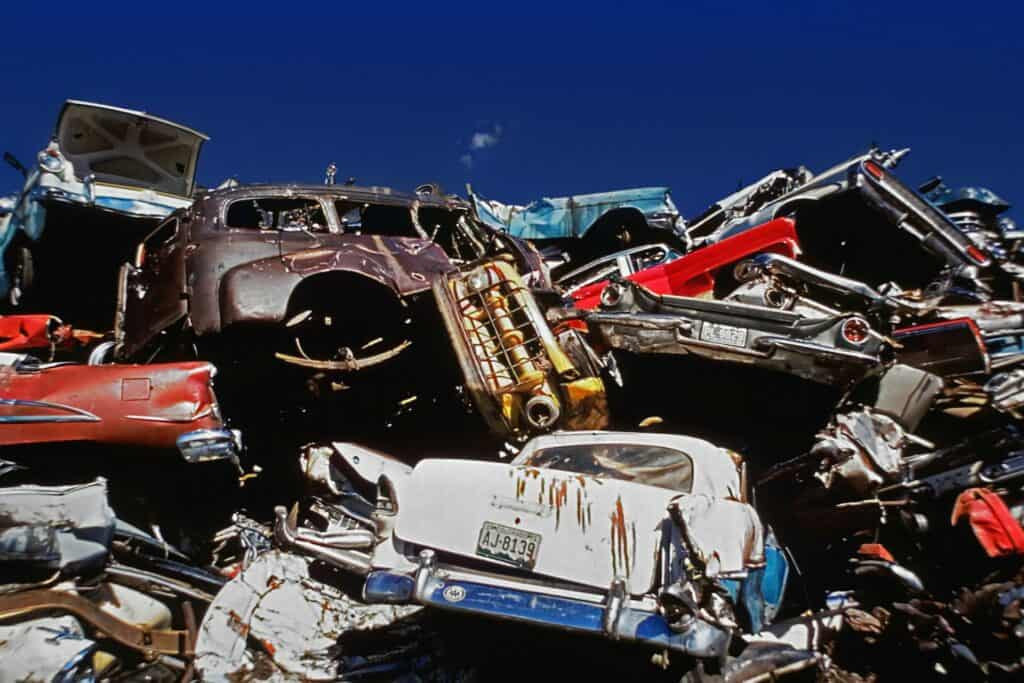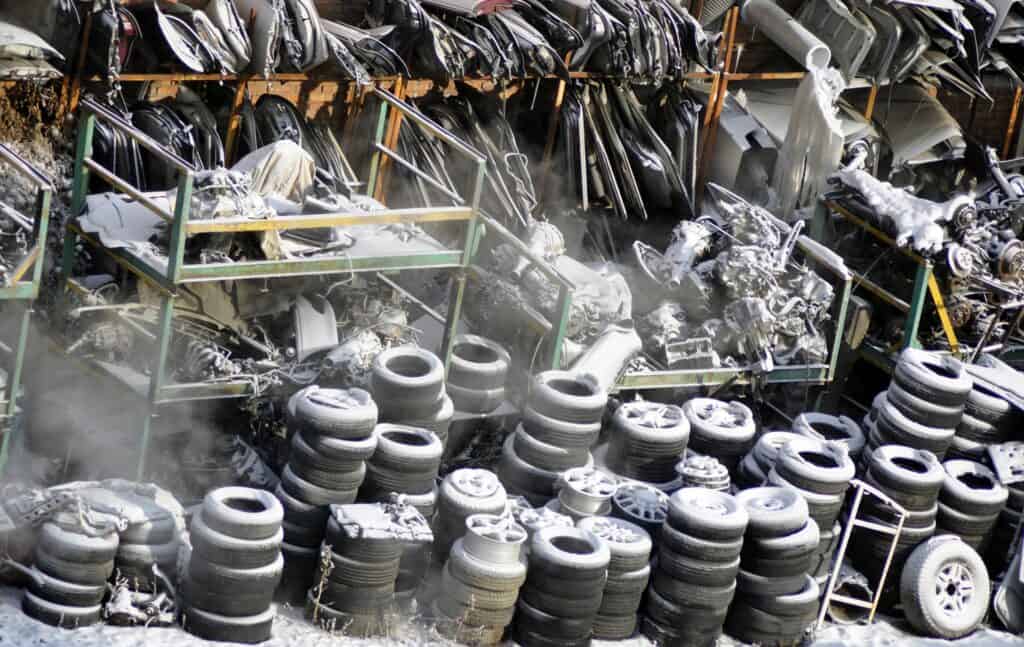Introduction – Car Recycling
Did you know that there is an entire car recycling process that takes place to reuse and recycle car parts? It’s a pretty complex process, but we’re going to break it down for you in this blog post. Keep reading to learn more about how car recycling works and the benefits of doing it.

Benefits Of Recycling
Recyclers are looking for new ways to reduce waste and protect the environment. One of the most promising methods is vehicle recycling. By breaking down an end-of-life vehicle and reusing its parts and materials, recyclers can keep a huge amount of scrap metal and plastic out of landfills. And, because recycled components have lower production-related carbon emissions than new ones, vehicle recycling has a positive impact on our net carbon budget.
In addition to being environmentally friendly, vehicle recycling is also good for the economy. It supports jobs in the recycling industry and helps to create new products from recycled materials. What’s more, by extending the life of a vehicle, recycling can help to reduce manufacturing and transportation emissions.
Recycling A Standard Car With An Internal Combustion Engine

Once a car has come to the end of its usable life, there are several different ways to recycle it. Here are the most common steps in the car recycling process:
1. Remove Engine Fluids
Drain fluids from recyclable cars before the process begins to guarantee safe disposal. A junkyard may opt to drain fluids on its initiative if it sells scrap automobiles as a first step in the recycling process.
Removing engine fluids from autos can speed up the recycling process and make it safer for customers to pull parts from the vehicles. It is safer for consumers and helps prevent fires on the salvage lot if you drain the fluids.
2. Take Away The Useful Pieces
Companies that specialize in recycling autos might save time and effort by taking the recyclable vehicles to a junkyard first. In addition, buyers frequently remove parts (such as rubber hoses, plastic reservoirs, and tires) from automobiles at junkyards to reuse them. There are parts that are within your skills to recover, for example reconditioning a dead lead acid battery.
3. Shred the Vehicle Frame
After removing the vehicle’s usable parts and potentially non-recyclable items (such as batteries, synthetic fabric seats, as well as certain grades of plastic), send the scrap metal through a car shredder that uses magnets to separate the non-ferrous and ferrous metals.
4. Mix Metals Together
For scrap metal to be useful to manufacturers, mix with other metals to increase its strength before shaping into a new car frame. The American Iron and Steel Institute (AISI) found that “Over 14 million tons of recycled steel are from end-of-life cars in 2014”. This is a figure that has increased over the previous decade.
5. Send To Manufacturers
Once the scrap metal has been combined with other metals, it is sent back to the automakers to be employed in the production of new car frames for the next line of automobiles. Producers can save money by switching to recycled metal from automobiles rather than purchasing new metal. It helps the manufacturer since it lowers carbon emissions from factories.
Recycling An Electric Vehicle
Recycling an electric vehicle (EV) shares some similarities with recycling an internal combustion engine (ICE) car, but also presents unique challenges due to its structure and components, most notably the battery.
1. Remove Battery Pack and Other Components
EVs do not contain engine fluids like ICE cars, but they do have cooling liquids for the battery and other high-performance parts, which need to be carefully drained. The significant step in EV recycling, however, is the removal of the battery pack. These batteries are commonly lithium-ion batteries and contain valuable and sometimes hazardous materials.
2. Battery Reconditioning and Recycling
Depending on the battery’s condition, it might be reused in a “second life” application. A battery that is no longer suitable for vehicle use might still hold sufficient capacity for less demanding applications, such as stationary energy storage.
If the battery is completely spent and cannot be reconditioned, it undergoes a specialized recycling process. The battery is typically mechanically crushed in a sealed environment to prevent hazardous materials from leaking, then metals like lithium, cobalt, and nickel are extracted and purified for reuse.
There are entire companies that devote themselves to recycling the batteries. One that we’ve reviewed on ShrinkThatFootprint is Redwood Materials.
3. Remove Useful Parts
Much like with ICE vehicles, salvageable components such as tires, seats, and various vehicle parts are removed for reuse. However, EVs may have more advanced electronic systems that are also worth salvaging, such as sensors and on-board computers.
4. Shred the Vehicle Frame
The process here is similar to that of ICE cars. The metal body of the EV is shredded and sorted into ferrous and non-ferrous metals for recycling. It’s important to note that the EV’s frame may contain more lightweight materials, such as aluminum, to counter the battery’s weight. These materials require different recycling processes.
5. Mix Metals Together
The extracted metals are combined with other metals to increase their strength and are then shaped into new forms for various applications, including new EV frames.
6. Send to Manufacturers
Manufacturers can use these recycled metals in the production of new EVs, reducing the demand for new metals and minimizing their environmental impact. They also use the recycled battery metals to produce new batteries, decreasing the need for mining these materials.
Look for Salvage Yards and Auto Recycling Centers to Recycle Your Car
The simplest way we’ve found is an auto salvage yard. Take your car to any of these salvage yards, or junk yards as they’re also called, and they will strip your car down to the most valuable parts to sell off. In general salvage yards love to take your scrap car. Not only are the parts worth something, but the car metal itself is a good source of value. This is because 90% of steel is recycled. Manufacturing steel is a resource intensive process. Recycling steel avoids the mining and iron purification steps and therefore is of great value.
Another way to access car recycling is by looking up the nearest automotive recycling center to you. Many of these centers are listed online and in the phone book. You can also often find people who recycle cars by searching online classified ads, or even through community groups or Facebook groups dedicated to car recycling.

Once you have found a few potential options for car recycling near you, it is important to research each one to find the best fit for your needs. Make sure to ask about things like pricing, convenience, and what kind of services they offer.
Other Top Places To Recycle A Car
You might not want to go to a salvage yard (after all, where are they?) and you don’t know where’s an auto recycling center. Well, consider these other options.
Scrap Metal Yards
Scrap metal yards will pay you for the metals found in your car. A scrap metal yard will help you recycle a car because they will pay you for the metals found in your car. Scrap metal yards often have the equipment and expertise to remove and process the metals from the car in an efficient and environmentally friendly manner.
They also have the capacity to recycle the metals into new products, such as steel and aluminum, which can then be used for a variety of different applications. Scrap metal yards are an excellent way to recycle a car and help reduce the environmental impact of car disposal.
Auto Parts Stores
Auto parts stores will sometimes take cars for free and then resell the usable parts. Auto parts stores will help you recycle a car by taking it for free and then reselling the usable parts. This helps to ensure that the materials used to build the car are recycled and reused. By reselling the usable parts, the auto parts store helps to reduce the amount of waste created by disposing of the car, as well as helps to reduce the environmental impact of manufacturing new parts. The money received from reselling the usable parts can also help to offset the cost of recycling the car.
Online Car Recycling Companies
There are a number of online car recycling companies that will pick up your car and provide you with a quote. An online car recycling company will help you recycle a car by providing a convenient, efficient, and cost-effective solution. First, they will offer you a free quote for your car.
Then, they will pick up your car from your location and transport it to their facility. At their facility, they will disassemble your car, remove all fluids, and separate out the metal parts. Next, they will recycle the non-reusable parts, and useable parts will be cleaned, tested, and reused in other vehicles. Finally, the metal parts will be recycled into new materials. One example is CarTakeBack.com
Is It Necessary to Go Through the Car Recycling Process?
There are several reasons why recycling a car is beneficial. First, it helps to reduce the amount of waste that ends up in landfills. Second, it conserves valuable resources such as metals and plastics. Finally, it reduces pollution by minimizing the need for new car manufacturing.
However, there are also some drawbacks to recycling cars. The process can be expensive, and it may not always be possible to find a buyer for recycled materials. In addition, recycling centers cannot often handle all of the cars that are brought in. As a result, many cars end up being sent to junkyards or incinerated.
So, is it necessary to go through the car recycling process? If you have an old car that you no longer want or need, recycling may be the best option. However, if you are simply trying to get rid of an unwanted car, there may be better options available.
Future Challenges For Car Recycling Process
Several challenges need to be addressed to make the process more efficient and effective. One of the biggest challenges is the increasing number of vehicles that are being scrapped each year. With more and more people opting to buy new cars, the number of scrap vehicles is likely to continue to rise. This creates a significant challenge for those involved in the auto recycling process. They need to find ways to deal with the increased volume of scrap metal.
Another challenge that needs to be addressed is the rising cost of metals. As the demand for metals such as iron and steel increases, so does the price. This makes it more expensive for those involved in the auto recycling process to purchase the raw materials that they need. In addition, it also means that they need to find ways to reduce the costs associated with transporting and processing these materials.
Conclusion
As we have seen, the car recycling process is a highly efficient and effective way to reuse materials from end-of-life vehicles. Not only does this reduce the amount of waste going to landfills, but it also reduces the need for mining and other forms of resource extraction. Moreover, recycling cars helps to conserve energy and protect the environment.
The car recycling process is an excellent example of how we can turn waste into a valuable resource. With the right infrastructure in place, we can recycle just about anything.
